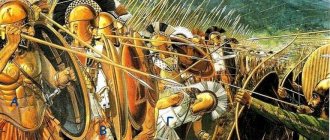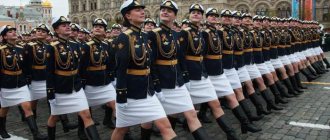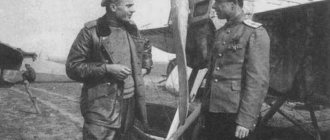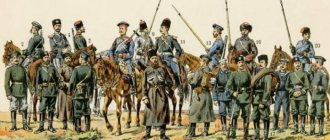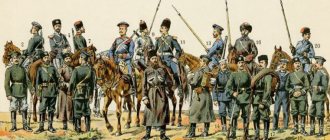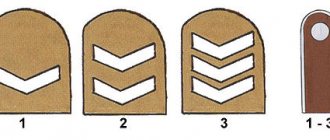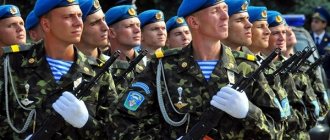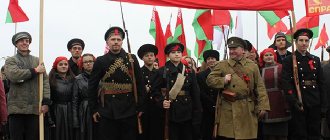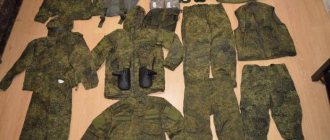The history of military uniforms does not go back to ancient times, as one might think at first. What we are accustomed to consider as a form appeared only in the 17th century, with the beginning of military reforms in Europe. However, the first examples of military uniforms can be seen already in ancient Greece.
Of course, the uniform army suit is a relatively recent invention, but a certain military style of clothing has always existed. You couldn’t just pick up a sword or bow and become a soldier in the eyes of your opponents. Let's take a short tour into the history of clothing of ancient warriors.
Military uniform of ancient times
The ancient world opened the door to the era of professional armies. Despite the fact that the armies of antiquity had a certain uniformity, it is impossible to talk about a standardized uniform. 300 Spartans in real Greece could only have the same red tunics - everything else looked individual for each hoplite. Even the Roman legionnaires, whom we are accustomed to seeing in films identically dressed and equipped, in reality were a rather motley formation. A Roman legionnaire, although dressed according to a certain standard, could have a difference in style with his brothers in arms in equipment, and the color of the shield also differed. This was due to the lack of mass production in those days. Even after the introduction of flexible armor (lorica segmentata), the Roman soldier did not receive real uniformity, since the style of armor differed depending on the region of production.
The fall of the Roman Empire marked the beginning of the Early Middle Ages, and with it the migration of peoples. The main participants in military clashes are nomads and tribes. It is hard to imagine that military uniforms appeared in these times, because the hordes of nomads and barbarians did not particularly care about uniformity. It was quite easy to distinguish friend from foe on the battlefield. The medieval period also did not give rise to the development of uniforms in more civilized countries, such as Byzantium and the remnants of the Roman Empire. Since armies were equipped at the expense of military leaders and kings, and were often simply hired, at best they had a certain common color palette.
Knight's color
When we look at the Middle Ages, we see uniformity there too. But this time it is connected with feudal relations and heraldry. The armies of that time were not “armies of kings,” but “armies of knights.” Well, each knight went to war with his own small detachment - a spear, which he rightfully dressed in the colors of his coat of arms.
For this reason, in the Middle Ages, heraldry was not only a sign of feudal vanity, but also an applied military science, which made it possible to figure out where the forces of a particular lord were in the heat of battle. Good kings of arms, who were in the service of the nobility, learned literally tens of thousands of coats of arms and should have been able to easily distinguish any one by identifying its owner.
Some peoples trace military uniforms straight back to knightly times. The etymology of the word "waffenrock" does not trace back to the war - "waffen", but to the coat of arms "wappen". That is, for a German, a military uniform is a direct successor to the coat of arms that a knight wore over his armor. At the same time, the etymology of the word “uniform”, that is, a military uniform in Romance languages, means “something that has a single form.” The military uniform was understood in the same sense in Russia, where, for mysterious reasons, it appeared almost a hundred years earlier than in Western Europe.
Military uniform of the middle period
The 17th century changed warfare for centuries to come, and with it the military costume. The advent of firearms made armor, swords, bows and other relics of the Middle Ages useless. The new army was formed from people with guns, for whom, in fact, nothing was needed except this very gun. It is much cheaper to maintain such an army, so in this era all states began to have regular armies. Such an army is supported by state money, so cost and the possibility of mass production in a short time become an important quality of equipment. Although cuirass-style armor still provides protection from bullets, such armor was and remains expensive to manufacture.
A new era in the development of military clothing
The military clothing of the new era took civilian clothing as its basis. Pants, shoes, top - all this in its outline and style was reminiscent of a civilian suit. A distinctive feature of the new time is the uniformity of uniforms and equipment. The new military uniform acquires color standards and clothing style. Now a soldier can be distinguished not only by what standard he marches under or whose coat of arms he wears on his shield. The color of the uniform “screams” about the army of which state he belongs to, and what his functions are. European powers issued uniforms of a certain color, which did not change for centuries. For example, the British armed forces of the time were famous for their red caftans, which quickly earned them the nickname “redcoats.” Here is a small list of European countries and their colors:
- Russia – green;
- Austria – white;
- Prussia – blue;
- Portugal – dark blue;
- Great Britain – red;
- France – blue;
- Sweden – blue and yellow.
The paint quality of the period left much to be desired, so multi-colored uniforms faded quickly and white uniforms often turned gray in a short period of time. Also, the choice of colors was limited (for example, red was worn not only by the British, but also by the Danes), so each state strived for a unique style and various distinctive features of its uniform, so that during battle a soldier could distinguish one from another. According to contemporaries, the most beautiful military suit belonged to the French army. By and large, the design of the uniform was almost identical throughout Europe. Whether it was a Russian or Prussian uniform, soldiers were usually dressed in a caftan, underneath it was a camisole, trousers or breeches with tights, shoes and a headdress, most often a hat. Due to the fact that uniformity had to be maintained, rules for wearing military uniforms appeared. The cavalry, being a privileged branch of the military, dressed more variedly and pretentiously. The color of their uniforms was different from ordinary troops, as were their headdresses, and the heavy cavalry, the cuirassiers, even had armor. It is interesting that the transition to a new form is taking place almost simultaneously in many countries. There was no originator of the form or pioneer. The Thirty Years' War, which was fought throughout Europe, made it obvious to everyone the need for such a revolution in the army. The Russian revolution was a little late, but overall it took place within the same time frame as the others.
After 400 years since the complete transition to firearms, all that military uniform designers had to worry about was how beautiful it looked and how well it matched the color palette pleasing to the sovereign. Even before the outbreak of World War I, a number of countries abandoned bright colors. The British Empire began to use khaki in India back in the mid-19th century, and then transferred this experience to their homeland. Many countries, such as the German Empire or France, retain the traditional coloring of the uniform. Of course, this list includes countries with blue or dark shades of uniform (Germany has traditionally been the keeper of the tradition of the Prussian army). The motley colors or white military clothing became unsuitable for service, and the experience of the First World War forced all armies to abandon even the small elements that adorn the soldier's military costume, such as the red trousers of the French army or the pommel on the helmets of the German army.
Uniform of the Workers' and Peasants' Red and Soviet Army
In 1918, the Red Army was created from the wreckage of the former tsarist troops and all kinds of volunteer detachments. Units appeared that fought for the new, Soviet power. The young republic spared nothing for their uniforms, but in the conditions of the confusion of the internecine war, it was not possible to make a more or less uniform uniform of a new model.
The main innovation was the abolition of shoulder straps and military ranks.
Now non-commissioned officers were called detached commanders, and generals were called corps commanders and brigade commanders. Instead of shoulder straps, sleeve insignia and buttonholes were introduced. With minor changes, they will exist until 1943, although they will be seen here and there at the front until the end of the war.
The problems of supplying the army with uniforms were solved with the help of the royal clothing warehouses. They also found one of the symbols of the Red Army in the Civil War, a unique headdress known as the budenovka. According to the most common version, it was created by the artist Vasnetsov for the Russian Imperial Army during the First World War.
In these headdresses, similar to the helmets of epic heroes, the soldiers had to parade through defeated Berlin. But the parade didn’t work out, but the Soviets happily took the opportunity to dress their supporters. The first name of the hat, hero, was quickly forgotten. In some places Budenovka was known as Frunzevka, in honor of M.V. Frunze, one of the main commanders of the Workers' and Peasants' Red Army.
During the Civil War, there were many signs on the uniform that distinguished the Reds from the Whites. Thus, red flaps, bows and stars were worn on overcoats and tunics. As the fighting ends, the uniform takes on a calmer tone. Only in the 1930s, on the wave of general upsurge and preparation for a new big war, did the Red Army acquire many innovations. The gymnasts have a turn-down collar instead of a stand-up collar.
Rank insignia and branch of service are determined by numerous lapel and sleeve insignia.
For each specialty, the edging and color on caps and caps are determined. Instead of caps, caps are being introduced everywhere, designed to be worn together with a helmet. But the color splendor of the Soviet military uniform ends in the summer of 1941. Colored buttonholes turned out to be too good a target and in August 1941 they were changed to khaki buttonholes.
The winter of 1942-43 was marked by the return of shoulder straps to the army. With minimal changes, this system will continue to this day. The Red Army soldier again dons a tunic with a stand-up collar and eyelets for shoulder straps. Experienced fighters, however, will keep their tunics with ripped buttonholes until the end of the war.
The tunics of privates and command personnel differed. Thus, privates did not have pockets on their chests, while officers had two external pockets, protected by a valve, and one internal one.
Tunics will serve until the 1960s. At this time, the Vietnam War will demonstrate the mighty and terrible power of napalm. Since the tunic is removed over the head, it is considered not the best uniform for a possible war. Tunics will replace the “hebe”, a jacket with buttons, known from many photos and films of the 1960s...1980s.
But “hebe” will also be an intermediate option. During the war in Afghanistan, the legendary “Afghan” will appear, a sand-colored uniform adapted for combat operations in any conditions.
Military uniform at the beginning of the 20th century
The First World War brought not only death and destruction, the destruction of many empires and a wave of revolutions, but also a new world, a new order and a new military doctrine. The German Empire - one of the main participants and instigators of the First World War - entered the war with a plan for the rapid capture of Paris, the surrender of France and the very early end of the war. The victory was so obvious that ammunition depots were designed to last only a year. The protracted four-year war became a real test, not only for the heirs of Prussia, but for all states. 4 years in the trenches under artillery fire and gas attacks made their own adjustments to what the military uniform of this century would look like.
It became obvious that the shape of the aircraft should not only be comfortable, but also unnoticeable. The colorful military clothing did not provide any opportunity for camouflage, which was not a problem before, because the effective range of a gun for 300 years was simply ridiculous, even by the standards of the beginning of the last century. In the 20th century, the distance grew to a significant one, and now the ability to merge with the environment could save a soldier’s life. Guns of the First World War could hit the enemy at a distance of 400m, so if in the First World War there were still countries that were armed with uniforms with bright or colorful colors, like French red breeches, then even before the beginning of the 30s all countries switched to khaki. Traditional colors and decorations become part of parades and celebrations. Many countries are beginning to use steel helmets for partial protection from bullets, shrapnel and rock that rises in kilograms into the sky when a shell explodes. In the period between wars, military uniforms lose everything unnecessary. German helmets, in the Prussian style, lose their tips in the same way as the famous Russian “Budenovka”, thereby increasing the soldier’s stealth.
The intermediate models of the First World War are being replaced by the uniform of a modern soldier. The helmet becomes an attribute of a soldier in any army (in the First World War, many armies did not use them), khaki or dark gray tones of the uniform become a priority. In the armies there is a transition to specialized uniforms, military uniforms appear for aviation and tank units, because before that they basically wore the same as parts of the regular army.
After the revolution, the Soviet leadership tried for almost two decades to develop a unique appearance for the new Soviet soldier, but in the end it came to the conclusion that the tailoring of military uniforms was modeled after the imperial army, due to the ease of tailoring and lower cost compared to those what the designers of the “new system” proposed.
By World War II, the differences between commander and soldier were completely erased. Only the top management could be distinguished by their uniform at first glance. The junior officers were no different from their ordinary colleagues. Previously, the officer was always visible and different ranks and types of troops differed in uniform. Now, for this purpose, insignia are used, such as: patch, buttonhole, shoulder strap, cockade and chevrons on the uniform.
Story
Military uniforms have always bore some resemblance to ordinary civilian clothing worn at a given time. Civilian fashion also influenced the development of uniforms and should therefore be taken into account when studying military uniforms of a certain period. It is worth noting that initially the difference between civilian and military clothing was less significant than one might assume.
Traditions have always played an important role in the development of uniforms, which is typical for all eras. Even the modern look of uniforms bears the imprint of ancient traditions. Over time, the details of the costume that indicated a particular era, although they lost their original purpose, were often preserved in the form of a symbolic ornament.
In those states where there was a caste system, the clothing of the warrior caste was also the uniform of the army. Generally speaking, initially every man capable of bearing arms was a warrior and went to war in the dress that he wore constantly; specifically military armor was very primitive and varied. However, the desire to distinguish one's troops from the enemy's from afar, as far as possible, led already in ancient times to the fact that the armed forces tried to have one-color clothes or at least distinctive signs with a variety of clothes. If any branch of the army had permanent and honorable significance, it also received distinctive signs of its dignity (for example, a detachment of “immortals” or the guard of the Persian kings).
"Immortals" with spears, depicted on the wall of the palace of Darius I in Susa. Around 510 BC
Janissaries
Ancient world
Roman legionnaires (reconstruction)
Military uniform , according to military historians, first appeared in Sparta, but this was only a consequence of the peculiar structure of the entire Spartan life: the regulations that prescribed the rules of washing, the schedule of dishes at lunch, etc., could not but affect such an important event as a performance to war, and did not provide the color of clothing most convenient for this purpose - and the Spartans chose red so that the blood flowing from their wounds would be less noticeable and would not confuse the faint-hearted.
The convenience of uniform uniforms could not help but be realized by other Greeks, and after them by the Romans. The Roman legions have something like a uniform in the modern sense: white clothes, uniform weapons and armor, and multi-colored feathers on the helmets, distinguishing the legion from the legion.
Ancient Roman legionnaires wore standard equipment and clothing. However, the concept of military uniform was not part of their culture and there were significant differences in details. Even the armor mass-produced in state-owned enterprises varied depending on its place of origin. Fragments of surviving clothing and wall paintings indicate that the Roman soldier's basic tunic was of red or undyed (off-white) wool . Senior military leaders were known to wear white cloaks and feathers. The centurions, who formed the old-time base of the legions, were distinguished by the cross plumes on their helmets, breast decorations corresponding to modern medals and the long staves they carried. A uniform :
- In the 1st-2nd centuries: paenula
(short dark woolen
cloak with a hood, a variant of the poncho ). - From the 3rd century: tunic with long sleeves, sagum - a cloak without a hood, previously incorrectly considered a classic Roman military one.
Late Roman Empire and Byzantium
Middle Ages
In the Middle Ages, there was, strictly speaking, no regular army, since the army was made up of vassals and their squires and warriors; there could be no question of any uniformity in the form of uniforms, but everyone wore the distinctive insignia of their master; The cut of the clothes was also approximately the same, depending on the rank.
The clothing of the rich barons and their servants was distinguished by luxury, which was the subject of rivalry between them. At that time, military uniform should actually be understood as the military armor in which they went into battle . Later, when mercenary detachments appear, a desire is noticed on the part of their commanders to dress their squads in the same way; These gangs sometimes received their names based on the color that predominated in their costume.
In the Middle Ages, the image of a cross began to be used as distinctive signs. So, for example, from the beginning of the 15th century, the British sewed a red cross on their chest and back, the French and Swiss - a white one , and the soldiers of the German Empire - the cross of St. Andrew or the Burgundian cross.
XVII-XVIII centuries
Uniforms appeared with the formation of standing armies after the Thirty Years' War (1618-1648). The idea of creating a uniform does not belong to any one country or one person, since it was introduced simultaneously in several countries. This happened for obvious reasons: it was necessary at first glance to distinguish one’s comrade from the enemy during the battle, as well as to indicate that the army belonged to a certain state. The uniforms in France and the states that were under its influence were distinguished by the greatest luxury. The most beautiful and varied of the forms in all states belonged to the cavalry. The Prussian and Swedish troops were dressed more modestly than others.
Crosses were replaced with scarves, which were worn on the belt or over the shoulder. The color of the scarf was chosen by the monarch himself, and therefore it usually corresponded to the colors of the royal coat of arms. For example, the Danish king Frederick II decided, as a decree of 1563 states, that “all who are part of the royal army must wear a distinctive sign in the form of a ribbon or scarf of red and yellow on their cap, clothing or over the cuirass.” These colors were the colors of the coat of arms of the royal House of Oldenburg. In 1625, entering the Thirty Years' War, Christian IV chose a scarf of blue and russet with a golden hue and complemented the headdress with a white feather. Later, the king returned to the colors of the House of Oldenburg, which still exist today. A symbolic reminder of the previous scarf is a lanyard in the form of a narrow twisted red cord with gold on the hilt of an officer’s saber.
In Sweden, the color of the scarf also changed. It was blue for the army of Gustav II Adolf during the Thirty Years' War, blue and yellow during the reign of Charles X Gustav, as it has remained to this day. During the Thirty Years' War, the Spaniards and soldiers of the German Empire wore red scarves, the French wore white, the Dutch wore orange, and the Saxons wore green. In England, Cromwell introduced the orange scarf, while the Royalists had white scarves. During major battles, it was considered necessary to complement the scarves with another distinctive sign, such as straw strands or green branches on a hat or helmet. This is how the soldiers of the allied armies recognized each other on the battlefield and easily distinguished themselves from the soldiers of the enemy coalition.
The introduction of uniforms caused some difficulties. At first, soldiers received uniforms, the cost of which was withheld from their salaries. Thus, the uniform belonged entirely to them and was not confiscated at the end of the service. Typically, colonels—the commanders and owners of the regiment—purchased and distributed military uniforms. This was unprofitable for the soldier, since every ecu saved did not go into his pocket, but into the pocket of the colonel. But as royal power strengthened, the influence of the colonels weakened. The appearance and details of the uniform, as well as the way it was worn, were approved by the orders of the monarch. Gradually, the supply of uniforms to armies began to be carried out centrally. In the event of liquidation or transformation of a military unit, the state reimbursed the cost of uniforms and distributed them among other regiments.
Initially, they tried to give a special look to the uniform of each regiment, but they quickly became convinced that it was preferable to introduce uniforms of the same cut for each branch of the army (and then the entire army), and military units to distinguish among themselves the shape and color of the collar, lapels, cuffs, and braid , braid, and buttons. However, some military units, such as the hussars, retained their special uniforms
The French Revolution and the wars that followed it, and then the constant growth of armies, led to the simplification and reduction in cost of uniforms.
Hussar uniform
The Russian hussar uniform borrowed a lot from the Hungarian
- Doloman - a short (waist-length) single-breasted jacket with a stand-up collar and cords, over which a mentik is draped
- A shako - with a plume, cords (etishkets) and a burdock. Since 1803. Before that - a hat .
- Sash with gombs (interceptions)
- Mentik - a short jacket (with laces), trimmed with fur, worn over a dolman
- Harness
- Leggings (chakchirs)
- Saber
- Boots (boots) - low
- Sarsan - clothing for hussar horses
- Tashka - bag
- Etiquette - cord with tassels
Everything was richly decorated with braid, cords, fringe and braid
Polish Hussars:
- Hussar armor - armor of winged hussars, including “wings”
- cavalry pike
- saber against opponents without armor or in chain mail
- konchar against opponents in armor
Uniforms after the Thirty Years' War
Military uniforms: 1. Army of the Electorate of Brandenburg, 2. French army of Louis XIV, 3. Army of Prince Eugene of Savoy, 4. Armies of Sweden and Russia (during the Northern War), 5. Prussian army of Frederick the Great, 6. Austro-Hungarian army of Maria Theresa , 7. Russian Army (Seven Years' War), 8. British Army (American Revolution)
Military uniforms: 1. Army of revolutionary France, 2. Army of Napoleon I, 3. British Royal Navy (late 18th century), 4. Prussian Army 1806, 5. Army of Brunswick 1809, 6. Army of Prussia 1813. , 7. Austro-Hungarian Army 1813, 8. Russian Army 1813, 9. British Army 1815
Uniforms of the French revolutionary general, officer and infantry soldier (1795)
XIX-XX centuries
It was only at the beginning of the 19th century that the custom was established of dressing the entire army, or its most significant part, mainly the infantry, in almost identical uniforms and distinguishing regiments by monograms on headdresses and signs engraved on buttons. This trend can be traced throughout the 19th century, but the desire to preserve traditions has not disappeared. Each state had the main color of the uniform of its troops: in Russia and Sweden - dark green; in Prussia and most German states - blue , in Austria - white , in France and Italy - blue , in Bavaria and the Netherlands - blue , in Great Britain and Denmark - red .
The rather bright colors of the uniforms did not change while muzzle-loading smoothbore guns had a negligible range. Later, the improvement in the effectiveness of firearms forced us to look at the uniform from a completely new angle. In order for the movement of soldiers on the ground to be invisible to the enemy, the uniform must match the color of the surrounding landscape. khaki khaki uniform was first introduced into the British Army (en masse during the Boer War of 1899-1902).
At the beginning of the 20th century, most countries chose almost the same cut for military uniforms. But guards and cavalry units in many cases still wore luxurious and ornate uniforms.
During the First World War, uniforms meeting this requirement were introduced in all belligerent armies. All types of troops had uniforms of the same cut and color. Distinctive marks consisted of small letters or numbers, as well as subtle icons and edging.
"Portrait of Life Hussar Colonel Evgraf Vladimirovich Davydov." O. Kiprensky
Cavalry Guards - Military uniform, 1914. Cavalry Guards Regiment of Her Majesty Empress Maria Feodorovna
Expeditionary Force of the Russian Army in France. Summer 1916, Champagne. The head of the 1st brigade, General Lokhvitsky, with several Russian and French officers, goes around the positions
Women's military uniform
Female personnel were always present in military service, performing mainly medical functions. Until the 20th century, these were not girls in military uniform, which only appeared for women after the First World War, when the number of women in the army increased significantly and their functions expanded. This was largely due to the advent and widespread introduction of typewriters, due to which an office worker became a necessity, especially during the wars, when most men went to the front and could not work in the rear. The new military uniform has become different from men's for female military personnel. Women who took direct part in the fighting naturally wore army field uniforms. Office uniforms took on the same color as any military clothing of the time, mostly khaki. The dress uniform was often white, but, for example, the Russian uniform was khaki, so there was no difference between what the dress uniform of men and women looked like in terms of color.
Modernity
Canadian and Afghan soldiers conduct joint patrols during the war in Afghanistan, 2010.
The constantly increasing accuracy and range of weapons, as well as mastery of airspace, led to the emergence of military equipment that provided maximum camouflage in various situations, without limiting freedom of movement. There are single-color and multi-color camouflages. The most “popular” color of solid camouflage, with which it is usually associated, is khaki . There are many color schemes for camouflage in different types of forests, deserts, snow, etc. Never before have military uniforms been so different from civilian clothing as they are today.
Military ceremonial costume
The second half of the 20th century brought more and more changes to uniforms towards utility, comfort and camouflage. Despite the mostly identical colors, a soldier of any army could be distinguished by the design of his uniform. Even in the heat of battle, amid smoke and soot, one can distinguish an American soldier from a Japanese or German soldier, and a Russian from a British or French one, by a simple outline. An interesting cultural feature began to appear during this period: the dress uniform, in which soldiers usually went on leave, became a relic of the past. Modern soldiers increasingly preferred civilian clothing or left the duty station in everyday military uniform. The dress uniform is now used only on special occasions.
Modern era of military uniform
Since the 50s, military clothing has evolved further in favor of camouflage and protection for the soldier. The coloring becomes complex, consisting of several colors. Black and dark blue uniforms are retained in the Navy, but some armies, state navies for example, are beginning to switch to a kind of naval camouflage. The boundaries between the rank and file and even the generals, who wear virtually the same uniform outside of headquarters, are becoming even more blurred. Insignia also become minimal, making it more difficult for snipers to kill command personnel. Military uniform sizes are increasingly varied to help every soldier feel more comfortable while on duty.
Body armor is becoming the norm and is gradually being introduced into ground forces around the world. Over time, the materials for making vests are improved and become lighter and stronger. A modern military uniform, in addition to body armor, can have protection for the neck, groin, shoulders, hips and even, no matter how funny it may sound, armored trousers, which can save the life of a soldier who has stepped on a mine. The special clothing of sappers is generally more reminiscent of knightly armor, which is difficult to move in, but which provides the maximum level of protection. The uniform and armor elements are now selected in accordance with the task that the soldier will perform. In addition to the corresponding uniform colors, all armor elements are removable, so the uniform can be modeled depending on the task that the fighter will have to perform.
